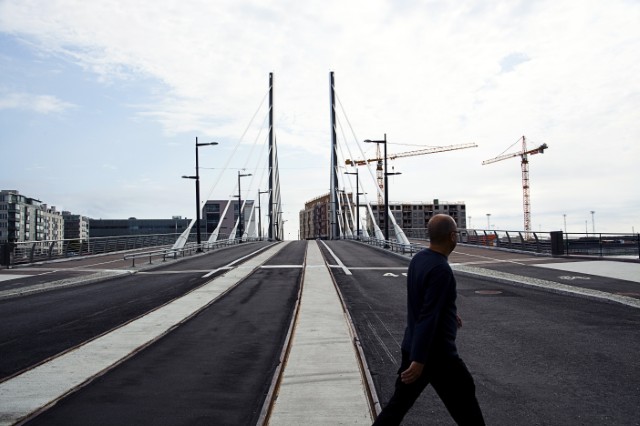A few weeks ago, a Picasso painting famously sold at auction for more than any other painting in history, helping to give the auction house Christie’s another record: more than 1 billion US dollars of art sold in a single week. A New York Times analysis shows that since the same Picasso last sold at auction in 1997, the number of people with sufficient assets to purchase such a painting has increased fourfold. The growth of income inequality is not a new story (it has been widely publicised that the US is the most unequal of Western countries), but this very public display and transparency of extreme wealth in an auction is unusual. It got us thinking about inequality – how “fractal” wealth inequality hides the staggering differences between the top one per cent of earners and the top 0.1 per cent, let alone the 99 per cent of earners in the United States – and the state of equality in Finland.
After the parliamentary election in April there has been a public discussion about potential divisions in Finland: is there a “bubble”, where some are considered inside, some outside? The main division, roughly, has been drawn between big cities and provinces, or between the cultural elite in Helsinki and the rest of the Finnish population. When the new government released its programme, speculation began about its impact upon different demographic groups. To better understand this state of division, Antti Kaihovaara has edited a book (Jakolinjojen Suomi, Kalevi Sorsa Foundation, 2015) which provides nine perspectives on the lines of divisions in Finnish society, including technological, health, regional, ethnic and cultural perspectives.
The most common line of division is usually made on the basis of material resources, income and wealth. Earlier this year, the Organisation for Economic Co-operation and Development (OECD) released a report, In It Together: Why Less Inequality Benefits All, which states that income inequality has reached record highs in most OECD countries and remains at even higher levels in many emerging economies. However, the gap between average incomes in advanced and developing countries is declining. The economists Tomas Hellebrandt and Paolo Mauro have found that from 2003 to 2013 the Gini coefficient of global inequality declined, meaning that there were fewer people at the extreme levels of poverty.
In international comparisons of the distribution of family income, Finland is still one of the world’s most equal countries, along with the other Nordic welfare model states. Compared to the United States, Finland has a relatively small wealthy elite, a greater percentage of people with an average income and a smaller percentage of people with a very low income. In Finland, 16 per cent of the population are at risk of poverty or social exclusion while the EU average amounts to every fourth citizen. The OECD report stresses the importance of the need to follow how income inequality is evolving, especially when a political agenda is dominated by worries about the growth and competitiveness of a nation.
The OECD highlights that growing inequality is harmful for long-term economic growth. The relationship between economic growth and income inequality is by no means straightforward. There are many interrelated factors such as trust, justice, social mobility and social and human capital that need taking into account.
Trust and social cohesion
In Finland, public trust has traditionally been high, both in people and institutions. Trust in government, the parliament and the police are good indicators of public confidence. The Finns traditionally have a very high trust in the police, but for Americans the question of trust in institutions is more political. As evidence, the military, which is typically understood to be apolitical by Americans, has become the country’s most trusted institution, while Congress, now the country’s most polarised political institution, is the body least trusted by the public. The Finnish Centre for Pensions recently reported that trust in pension security clearly diminished between 2011 and 2014. This might be a weak signal of rising mistrust and needs to be understood in the context of the pension scheme’s primary purpose of guaranteeing income security.
Among the general population, the wider the differences in people’s life experiences the more trust tends to reduce and the greater the divisions become. Building trust and understanding requires common arenas where people can encounter different socio-economic and cultural backgrounds, for example libraries, markets, residential areas, schools and kindergartens.
Early childhood day care, the education system and gender equality in employment are institutional factors that define societal equality. In Finland, the universal, common and free education system (and schools serving free lunch!) has a crucial role in fostering social mobility and equality of opportunities for children, despite their socio-economic background. The differences between schools are small and, until now, the choice of school has had a minimal effect on learning results. But in Helsinki, a constantly growing social and spatial differentiation is starting to be reflected in schools. Early childhood care provided by local authorities has an important role for social mobility and for enabling the employment of women. The employment rates of men (69%) and women (68%) are very close in Finland. In the United States, some 73% of men are in paid work, compared with 62% of women. Nevertheless, in this case we could do even better and learn something from the models of family benefits and part-time working in Sweden.
In Finland, redistribution through income taxes and social security is high, compared to the US where it is low. A challenge for the new government in Finland is to boost growth and competitiveness without losing the strengths of social cohesion. To fully utilise all future potential, nobody should be left behind. However, the social security system needs to adjust to a new kind of requirement: a rapidly changing working life. As the OECD reports, the increasing share of people working part-time, on temporary contracts or in a self-employed capacity is one important driver of growing inequality.
Lines of division in the future?
Antti Kaihovaara concludes in his book that Finland is not yet broken, but Finns are at a crossroads. Political decisions today need to be assessed to see whether they will lead to a state of greater inequality in future.
Will future generations have equal opportunities for quality of life, in a manner that is socially, economically and ecologically sustainable? New kinds of cultural, political, economic and environmental issues may challenge equality. It is good news that the fall in global income inequality is expected to continue into the future. However, in developed countries, we are likely to continue to experience increasing inequality so long as public policy enables wealth to accrue to those at the top of the income scale as it has done in the US since the 1970s.






Recommended